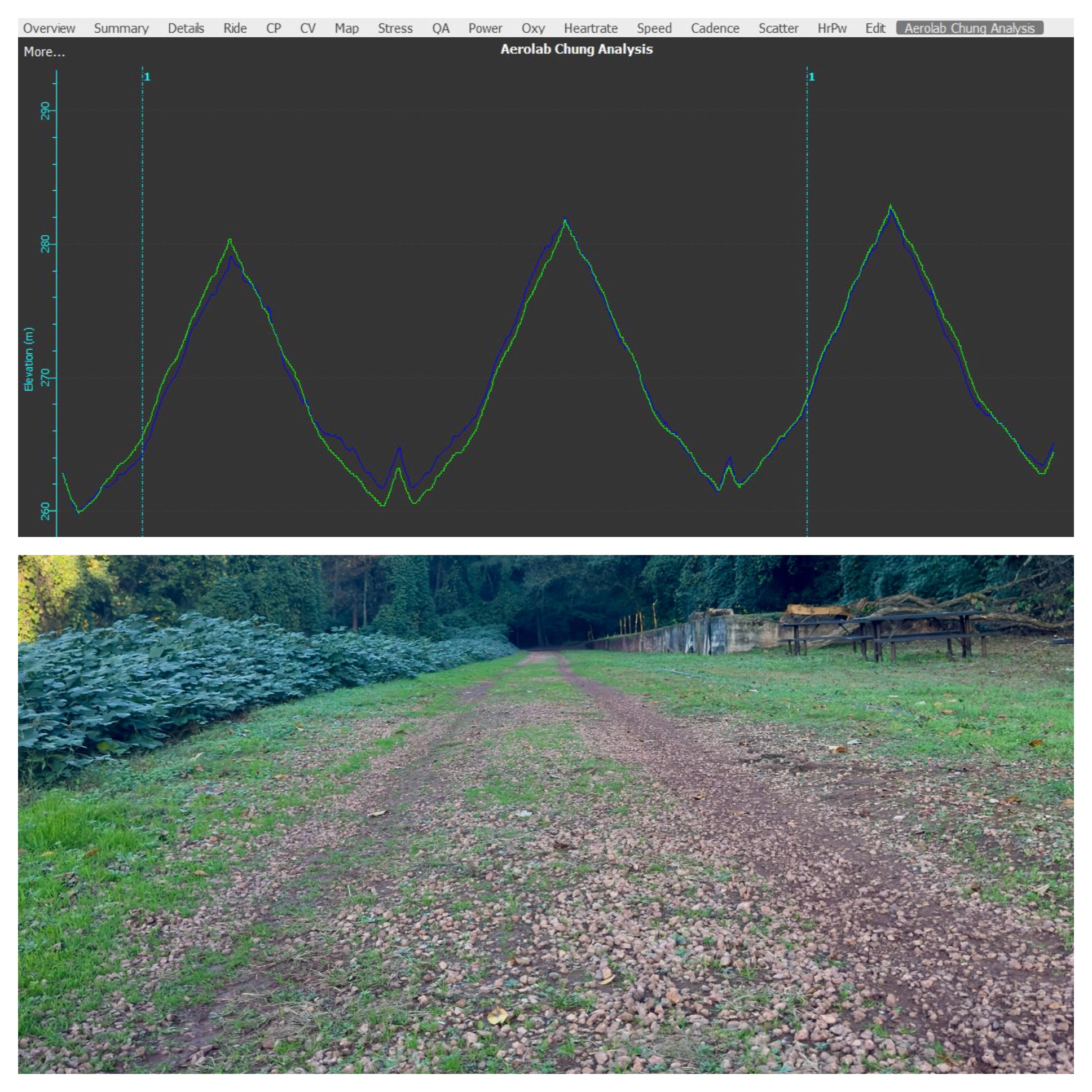Welcome! This is home base for the Chung Method tire testing I am doing. You are probably here for the juicy stuff… so I won’t keep you waiting! The table below shows the latest Crr values (smaller values are faster) across all tested surfaces. I’ve learned the best area to test is the Cat 2 track as it gets good separation in rolling resistance values and is the best thing I have for a consistent “average” gravel test. I’m saving the Cat 3 area mainly for 2.4 ish XC tires from here and the Cat 1 is not mandatory now that I know the trends but very close to home and often free of wind so I’ll likely keep doing it.
The gravel scene in the US (I feel like a moron saying that but hang with me for a minute please…) has lots of folks thinking about their tire choices thanks to numerous pros in the Lifetime GP series very obviously maxing out their tire clearance…and doing quite well with it
Payson McElveen’s Allied Mule prototype
I am gathering test data on what tires are fast or not so fast off road …while also addressing the related aerodynamic and weight factors! Weight and aero differences are factored into the “Power to hold 15 mph” column in the photo below. This uses tested CRR values to calculate exact power to hold a speed. I know it sounds backwards but with known coefficients, this is WAY more accurate than attempting to go out and ride an exactly flat course over and over. Steve Gribble’s website, The Computational Cyclist, is a fantastic spot to visualize changes from what might at first seem like trivial differences in CdA or Crr values.
Many riders don’t do ALL of their riding on one certain type of gravel,,, it varies, and often has a good bit of pavement mixed in. Mixed surface rides bring their own questions, such as how much power one might need depending on the ratio of gravel to pavement. The photos below illustrate this scenario for riders at midpack amateur speeds as well as those closer to pro level speeds. The actual Instagram post on these photos is with the other IG posts a bit further down the page!
The Cat 1, Cat 2, and Cat 3 gravel classifications I am using are adapted from those included in Silca’s TIre Calculator and VERY similar to their photos. You will notice Cat 4 Gravel is very rough…I have messed with this a little and the CRR values drift into the .0200 sort of range, which is very close to mountain bike tracks.
I have been posting most of the testing on my Instagram … it is important to me that this is easy to understand. This stuff gets confusing FAST. If you use IG at all, definitely stay in touch with it there, I throw a good bit of things out on Stories before they are ready for a real post. The posts blend in some with my other content there, so I am also keeping them here:
Power to hold 15 mph on Medium Rough Gravel.
So…what does a test day look like with this?
Whatabout really fast and smooth gravel?
Schwalbe Thunder Burt Super Ground 29 x 2.1 update
Into the Gnar… Cat 3 (Rough) Gravel testing
Race King 2.2 v Terra Speed 45: Mixed Surface Scenario.
Spring Classics Edition - Cobblestone vs Gravel CRR Values
Hutchinson Caracal Race Cat 1 Comparison
Testing the “Fastest Gravel Tire Available” on 3 gravel tracks
Hunt Limitless 40 Gravel Aero wheel testing
Mixed Surface Comparison of Thunder Burt 29 x 2.1 and Caracal Race 700x40
Specialized Tracer 700 x 50 test results
I’ve done all kinds of testing over the last 15 years, but my current methods are mainly focused on the Chung Method. For anyone halfway into the pdf… the testing is simple in format but NOT easy to pull off well! This YouTube video from Silca (Aero testing expert explains how to get accurate aero testing at home) has a fantastic interview with Robert Chung reviewing some testing files before the 2024 Unbound 200. Dr. Chung was recently on the Performance Process podcast with Ronan Mc Laughlin. Check it out on Spotify here. The full version is available for Escape Collective members.
Ronan was also kind enough to host me on the Performance Process podcast to talk about my tire testing…recorded right after the episode with Dr. Chung himself. Check it out free on Spotify here… all Escape Collective members have access to the full episode along with an incredibly thorough article that brings together my testing with Ronan’s insight: Real-world testing hints that MTB tires are faster on all gravel.
If the testing still sounds like black magic. I get it. As a contrast, think about this…How many folks tell you this stuff like, “I switched to X and got a Strava PR after using Y the time before that!” That’s interesting, but ya can’t do much with it. A vs B basic field testing has a place in the mix, and that is how I did mine before learning this way.
Peyote Cat 1 Test
Chung testing (aka Virtual Elevation) can provide an actual CRR (coefficient of rolling resistance) and CdA (coefficient of aero drag) which then can help model ALL kinds of riding scenarios, whether on or off road! The Race King vs Terra Speed scenario at the start of this is a good example. See the FAQ at the bottom for more talk about coefficients, which can be somewhat mysterious.
Cat 1 Gravel. EASY.
Cat 2 Gravel. Medium
For tire testing, we of course have the Bicycle Rolling Resistance website, which I pay the small fee for a membership even though much of it is free. I like it. Some think it tells ya everything about what tires are always fastest off road and some think it is dumb because “conditions are always changing”. It has its place of value, for sure. The indoor drum data and my outdoor testing has been a potent combo so far, as you can start to see the info we have all wanted:
Cat 1 to Cat 2 Breakpoint
Cat 2 to Cat 3 Breakpoint
Interesting, right? Some fast tires on drum testing remain fast off road and some less so. General trends are appearing and some of the wild bike setups from the Lifetime Grand Prix (for real though… what is Dylan Johnson so excited about?) are starting to make more sense. I don’t have all the answers, but I have a few, so I will keep testing.
Cat 3 Gravel. The Gnar.
FAQ:
What about tire psi?
It does matter, that is for sure. I am usually testing off road with the rider’s preferred pressure, which also ends up usually VERY close to what the Silca or Wolf Tooth calculators would serve up as a suggestion. The goal is to get a “best case” for each tire, which is fairly easy. Finding the “magic” tire pressure has more to do with getting the right feel and handling.
I tested this recently for anyone who REALLY needs to see it!
Wait, so you rode all those at exactly 15 mph? I see that column there….
NO! Notice that column says calculated… I tested to get CRR on gravel and used that value with an average gravel bike with rider CdA value and calculated the wattage required. This gets an exact wattage for easy comparison of the whole picture!
Aren’t wider tires less aero?
Absolutely. The Swiss Side link below in the Resources section goes over this. There seems to be much more possible variation in CRR wattage than aero wattage swapping between different tires. Tom Anhalt has blog posts on this HERE and HERE as well. I have tested this, and my findings are in line with Swiss Side and Tom, as well as some of the wind tunnel data I have seen from Silverstone in the UK.
Why all the decimal places?!
It is the nature of the beast with this kind of data…presenting it as direct CRR values avoids any confusion of whether the value is one or two tires….it is the same either way as a coefficient! CRR values for each surface also easily give us the ability to calculate wattage at different speeds and gradients to simulate racing or riding scenarios. The same is true of CdA values. These numbers seem quite small but create serious changes in the power it takes to make a bike move.
What power meter are you using?
For most tests, I am using Favero Assioma MX 2 Pro dual sided pedals. I calibrate them before each test after riding around some. I like them. Some tests are done with other rider’s bikes and a different power meter but with careful course selection, even the single sided power meters are enough to get pretty good results!
Are you testing on pavement, too?
Yep. All the time. The values I have gotten are so close to the BRR drum data that I am just using the BRR test data (Extra Low in each case) in the columns to keep things simple. Remember on the BRR website they give CRR values in addition to the wattage values…they just aren’t quite as in your face. I mainly use pavement tests now to pull apart CdA from CRR to make the gravel analysis in Aerolab easier later on.
What outdoor temperature are you testing at?
It varies but a loose target is 68° F / 20°. Anything off this is scaled to ensure consistency. We have generally mild weather here, which makes this easier.
But, my old tires felt faster. Are you saying to ignore that?
Yes.
RESOURCES:
Bicycle rolling resistance under winter conditions
Impact of Wheel Size on Energy Expenditure during Mountain Bike Trail Riding
More Speed, Less Power Offroad Tire Testing
Performance differences when using 26 inch and 29 inch wheel bikes - Swiss National Team
Simulation of transient rolling resistance of bicycle tyres at various ambient temperatures
Swiss Side Gravel Tire Width Aero Impact
Tyre Volume and Pressure Effects on Impact Attenuation during Mountain Bike Riding
If you have questions, feedback, or want to compare notes just leave a comment below or email me at johnkarrasch@gmail.com















